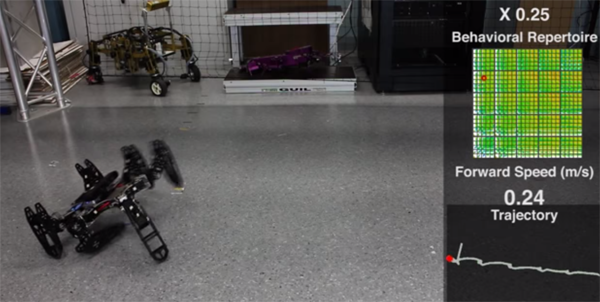Researchers have developed a robot that can figure out in just a couple of minutes how to get around despite one limb being incapacitated. It could make it more viable to use robots in remote locations.
The project involved staff in universities in Paris and Wyoming who’ve just published a research paper. They wanted to tackle the problem of most robots becoming as good as useless if a limb malfunctions, a particular problem if a human operator isn’t on hand to fix it.
Though the process of working out how to adjust walking with one limb out can be broken down into a distinct sequence of trial and error, the sheer number of possible combinations of adjustment makes it a lengthy process. In the experiment, the researchers used a six-legged robot powered by 18 motors. The combination of the individual movements of each motor adds up to a huge number of different walking patterns, each known as a specific gait.
The scientists’ approach to the problem was to gather data on 13,000 different gaits and group them based on the relative positions of each limb during walking. As and when the robot breaks a limb, it can choose the group that has the affected limb in contact with the ground for the least amount of time. The robot still needs to use trial and error to find the best possible gait, but the process is much quicker as it’s working from a smaller range of potential solutions.
The researchers say some of the tactics the robot picked were surprising. In some cases the “injured” robot adjusted by switching to springing rather than stepping. In one case it even flipped on to its back and began walking on the robot equivalent to shoulders.
Testing shows that not only does the revised approach reduce the time the robot takes to get back in action (always less than two minutes and sometimes just a few seconds), but it now has time to refine its selection rather than pick the first option that gets it moving.
On average the gait it now picks after injury is seven times more efficient than the most basic walking style of moving three legs together, then the other three legs together. Indeed, even when the robot has full use of its limbs, it’s now able to pick a gait that lets it walk 30 percent faster than the basic walking style.

